Chive Blossom Vinegar
This Post May Contain Affiliate Links. Please Read Our Disclosure PolicyHarness the vibrant colors and delicate flavors of fresh chive blossoms with this homemade chive blossom vinegar. It adds a kiss of chive flavor and uniqueness to so many dishes. Learn how easy it is to make and how you can use it to enhance and flavor a variety of recipes.
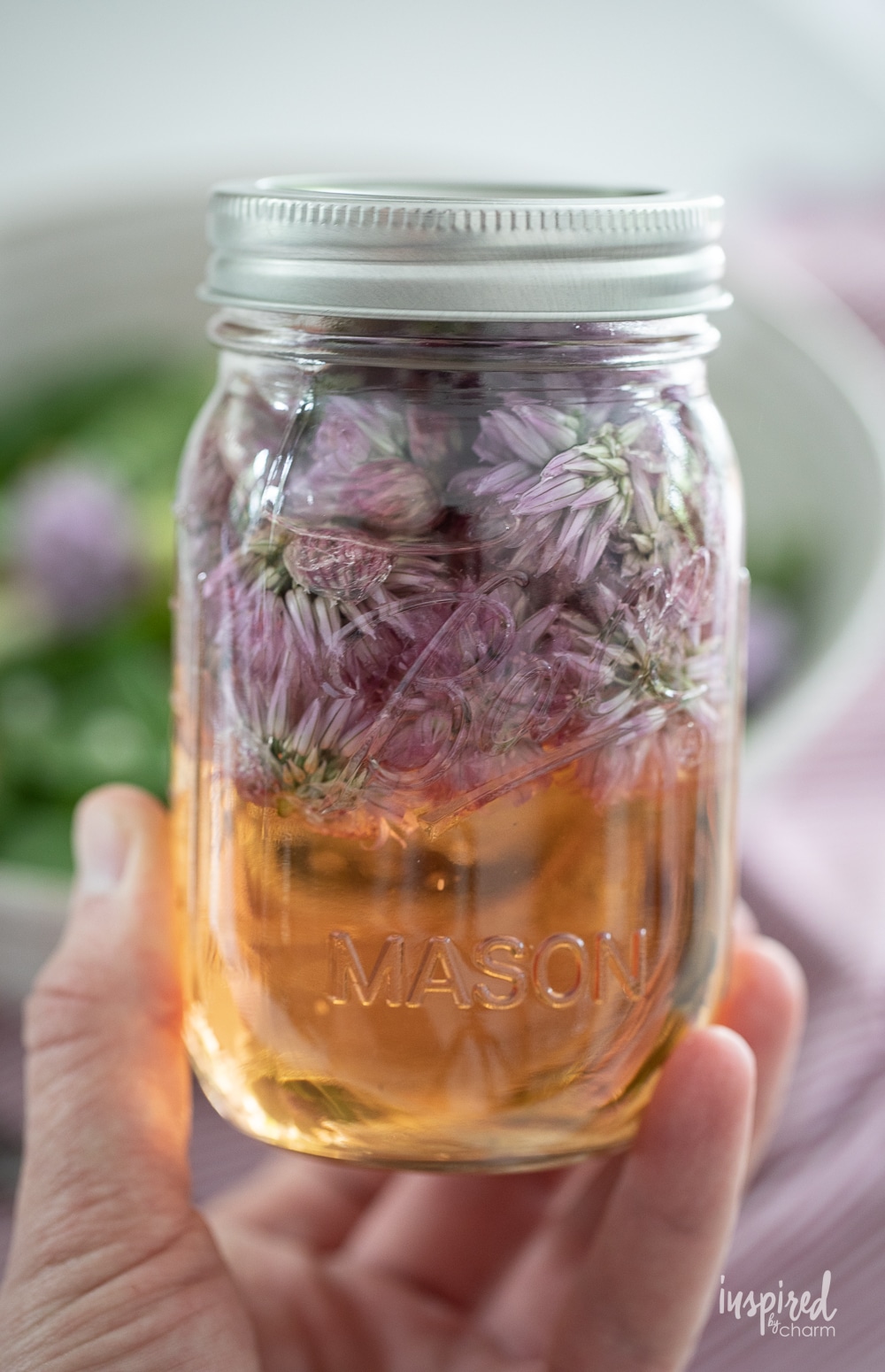
Did you know chive blossoms were edible? (They are!) I love them because they add a delicate onion-garlic taste to any dish. Since chive blossoms are very mild, they provide that flavor found in chives without overwhelming other ingredients.
I discovered this a couple of years ago when my friend Liz of Floating Kitchen shared a salad recipe that had chive blossoms sprinkled on the top. The pop of light purple color made the salad look so inviting and delicious. When the blossoms from my chive plant started to open this year, I researched some recipes and found that you could use chive blossoms to infuse vinegar with that delicious flavor and color. Love that!
Making chive vinegar at home requires just a few ingredients and minimal effort. With fresh blossoms, white balsamic vinegar, and a little bit of patience, you can create a condiment that will help elevate your cooking to new heights. The process of infusing the vinegar with the essence of chives creates a flavor profile that is unmatched. And the best part? You can customize the intensity of the chive flavor based on your personal preference.
Why You’ll Enjoy This Recipe
- This recipe provides an excellent way to make use of chive blossoms when they are in season and abundant. By infusing them in vinegar, you can preserve their flavors and enjoy them throughout the year.
- Chive blossoms infuse the vinegar with a delicate, slightly onion-like flavor, adding a unique twist to your dishes. The resulting vinegar is both aromatic and flavorful.
- Chive Blossom Vinegar can be used in a wide range of recipes. It adds a tangy and herbal note to salads recipes and dressings, marinades, sauces, and vinaigrettes. (More on that below!)
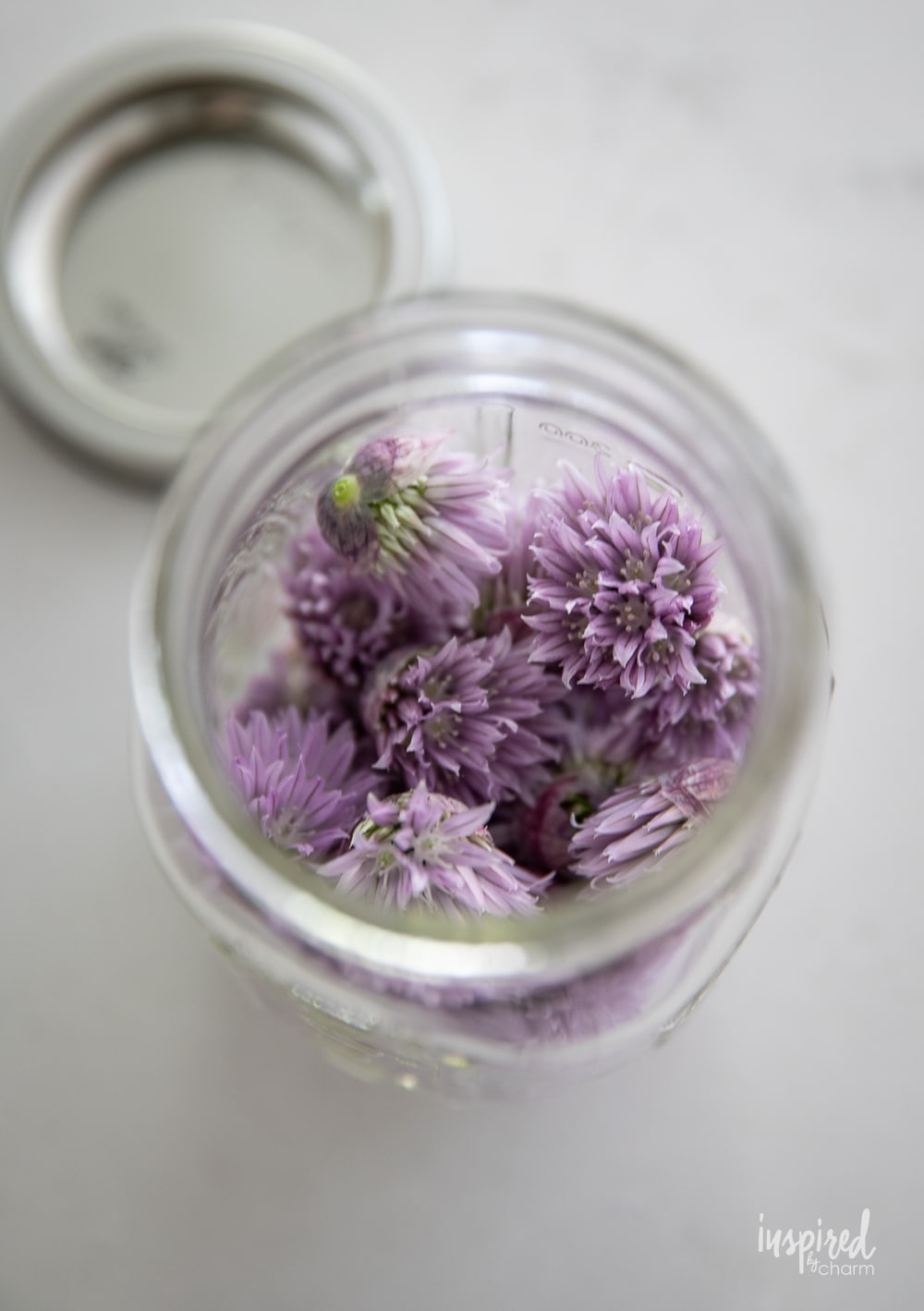
Ingredients
One of the best parts of this recipe is that you only need two ingredients: fresh chive blossoms and vinegar. Love that!
- Fresh chive blossoms – Chives are perennial (at least they are here in Pennsylvania). This means that once planted they will continue to come back year and year. Over time the plant will become more robust and provide lots of blooms for all of your recipes.
- Vinegar – While this recipe calls for white balsamic vinegar, you can experiment with different types of vinegar to suit your taste preferences. Red wine vinegar, apple cider vinegar, or champagne vinegar are all viable alternatives that can yield different flavor profiles.
That’s it! Super easy. Now, let’s make some infused vinegar.
How To Make
It couldn’t be easier to make this chive blossom vinegar. Follow the simple instructions below. I’ve also provided a full ingredient list and detailed instructions in the printable recipe card at the end of this post.
- Begin by gently rinsing the chive blossoms under cool water to remove any dirt or debris. Pat them dry with a clean kitchen towel or paper towel.
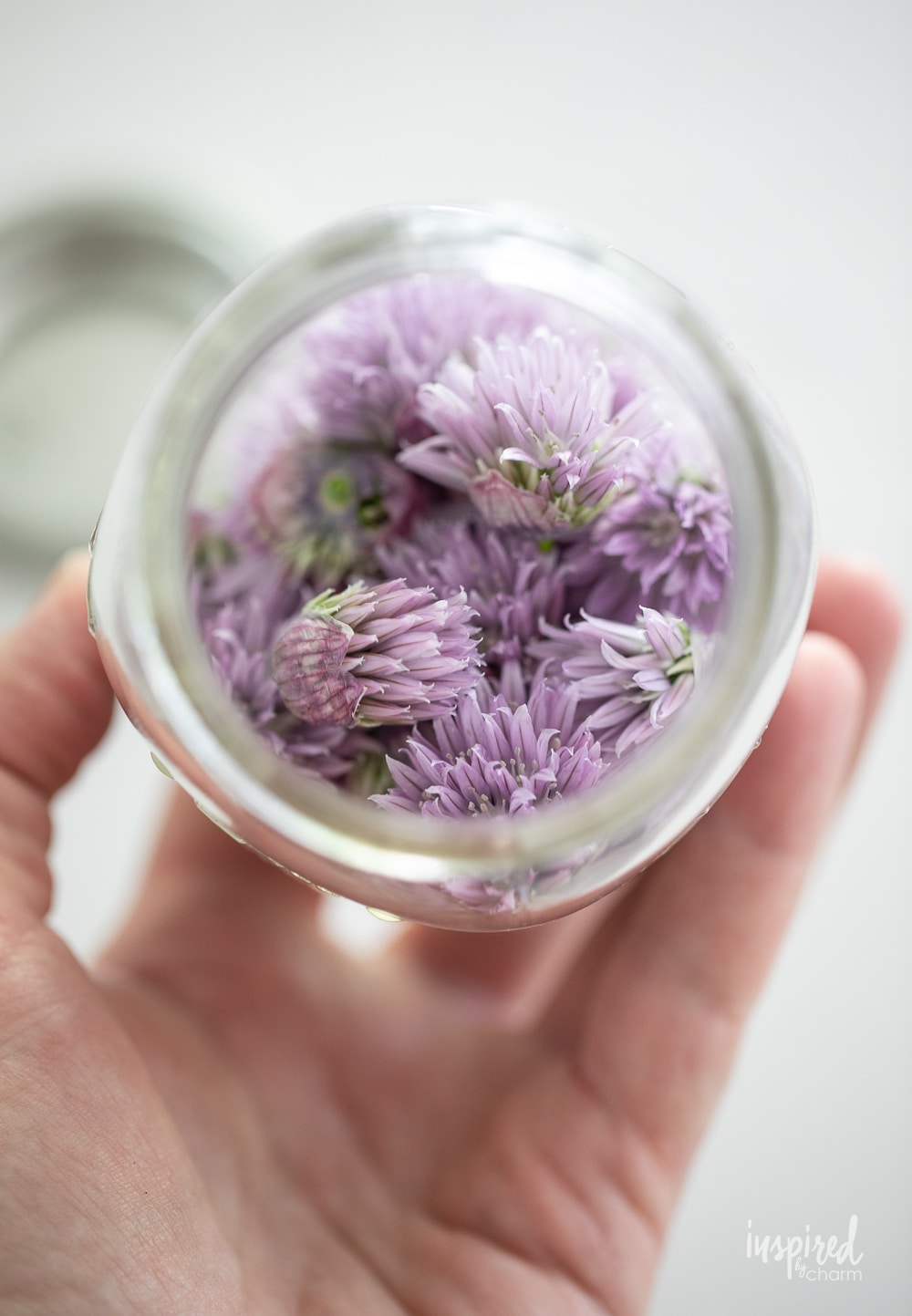
- Place the chive blossoms in a clean glass jar or bottle with a tight-fitting lid.
- Pour the white balsamic vinegar over the chive blossoms in the jar. Ensure that the blossoms are fully submerged in the vinegar.
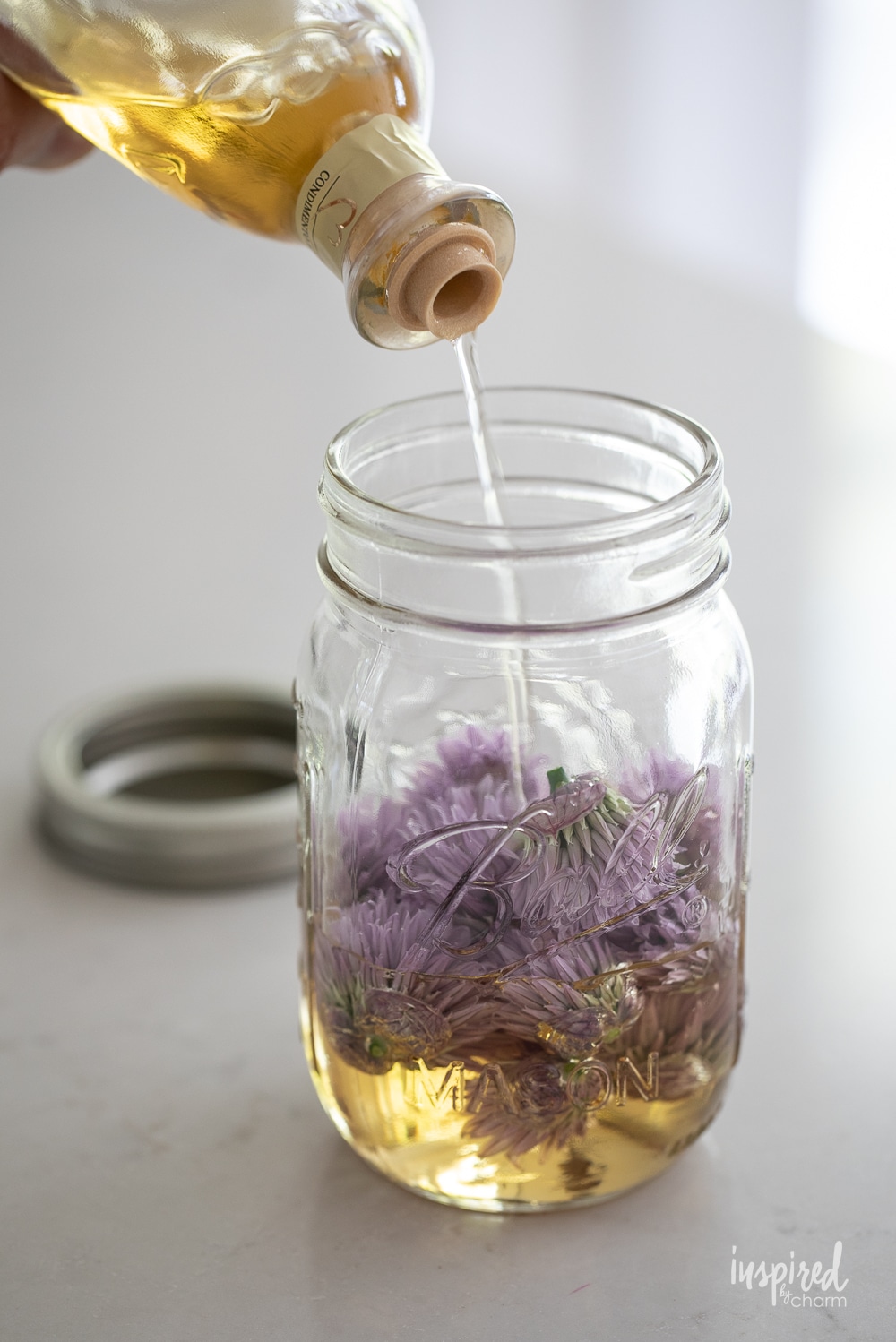
- Use a clean spoon or chopstick to press down on the chive blossoms, gently bruising them to release their flavor.
- Seal the jar tightly with the lid and place the jar in a cool, dark place such as a pantry or cupboard.
- Allow the chive blossoms to infuse in the vinegar for about two to three weeks. During this time, the vinegar will take on the delicate flavor and vibrant color of the chive blossoms.
- Shake the jar gently every few days to help distribute the flavors and encourage the infusion process.
- After the infusion period, strain the vinegar through a fine-mesh sieve or cheesecloth into a clean bottle or jar. Discard the used chive blossoms.
- Store the chive blossom vinegar in a cool, dark place. It will continue to develop flavor over time and can be used in various recipes, dressings, marinades, or as a flavorful addition to salads.
It’s as easy as that. You just made your own homemade infused vinegar. Now let’s put it to use!
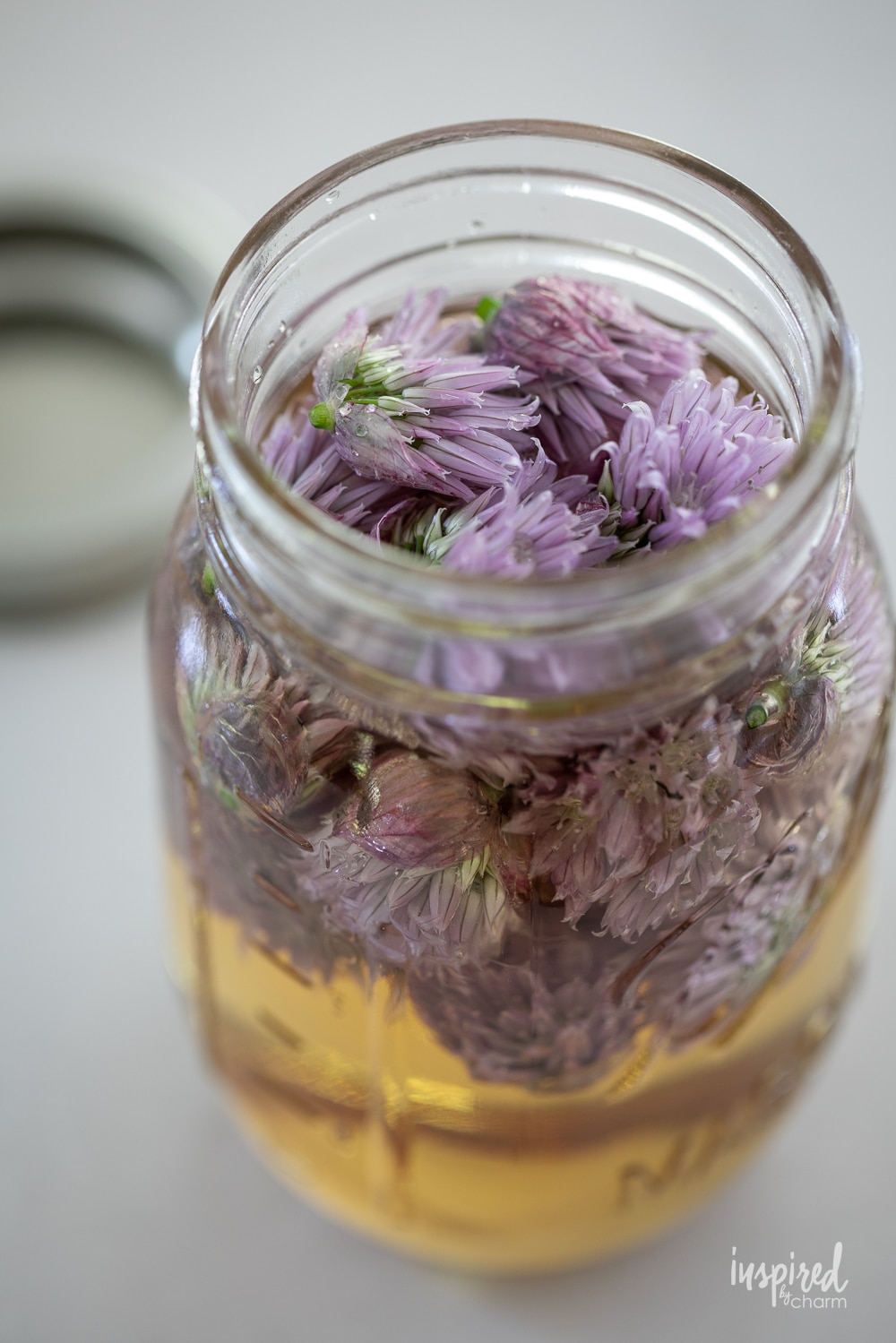
How to Use
Okay, now you have this delicious homemade chive blossom vinegar and you’re wondering what you’re supposed to do with it. Well, you’re in luck because I have lots of delicious ideas. Let’s get into them.
- Salad Dressings: Use chive blossom vinegar as a key ingredient in homemade salad dressings. (Or just drizzle it on your favorite salad recipe.) It adds a tangy and herbaceous flavor that pairs well with a variety of greens. Combine it with olive oil, Dijon mustard, honey, and a pinch of salt and pepper for a simple and delicious dressing.
- Marinades: Add a splash of chive blossom vinegar to your marinades for meats, poultry, or vegetables. It will infuse them with a delicate onion-like flavor and help tenderize the proteins. Mix it with your choice of oil, garlic, herbs, and spices to create a flavorful marinade.
- Vinaigrettes: Create vibrant and flavorful vinaigrettes by combining chive blossom vinegar with extra virgin olive oil, a touch of honey or maple syrup, Dijon mustard, and salt and pepper. Drizzle it over roasted vegetables or grilled meats, or use it to dress hearty grain salads.
- Pickling: Use chive blossom vinegar as a pickling liquid for vegetables such as cucumbers, radishes, beets, or red onions. The vinegar’s flavor will infuse the vegetables, giving them a tangy and slightly onion-like taste. Enjoy them as a topping for sandwiches and burgers or as a side to charcuterie boards.
- Sauces and Reductions: Incorporate chive blossom vinegar into sauces and reductions to enhance their flavor. Use it as a finishing touch in creamy sauces for pasta, drizzle it over roasted meats, or deglaze the pan with it to create a flavorful sauce to accompany your dishes.
- Cocktails and Mocktails: Add a splash of chive blossom vinegar to your favorite cocktails or mocktails for a unique twist. It can provide a tangy and herbaceous note to drinks such as spritzers, martinis, or even homemade shrubs. Experiment with different combinations and garnishes to create refreshing and flavorful beverages.
- Roasted Vegetables: Drizzle chive blossom vinegar over roasted vegetables, such as asparagus, potatoes, or Brussels sprouts, before serving. The vinegar adds brightness and depth of flavor, complementing the natural sweetness of the vegetables.
- Dips and Spreads: Incorporate chive blossom vinegar into delicious dips and spreads. Add it to homemade hummus, aioli, or sour cream-based dips for a tangy and aromatic flavor. Serve with fresh vegetables, crackers, or bread for a delicious appetizer or snack.
- Fruit Salads: Create a unique twist on fruit salads by adding a splash of chive blossom vinegar. It adds a subtle tang and pairs well with fruits like strawberries, watermelon, or citrus. Combine it with a touch of honey and fresh mint for a refreshing and vibrant fruit salad dressing.
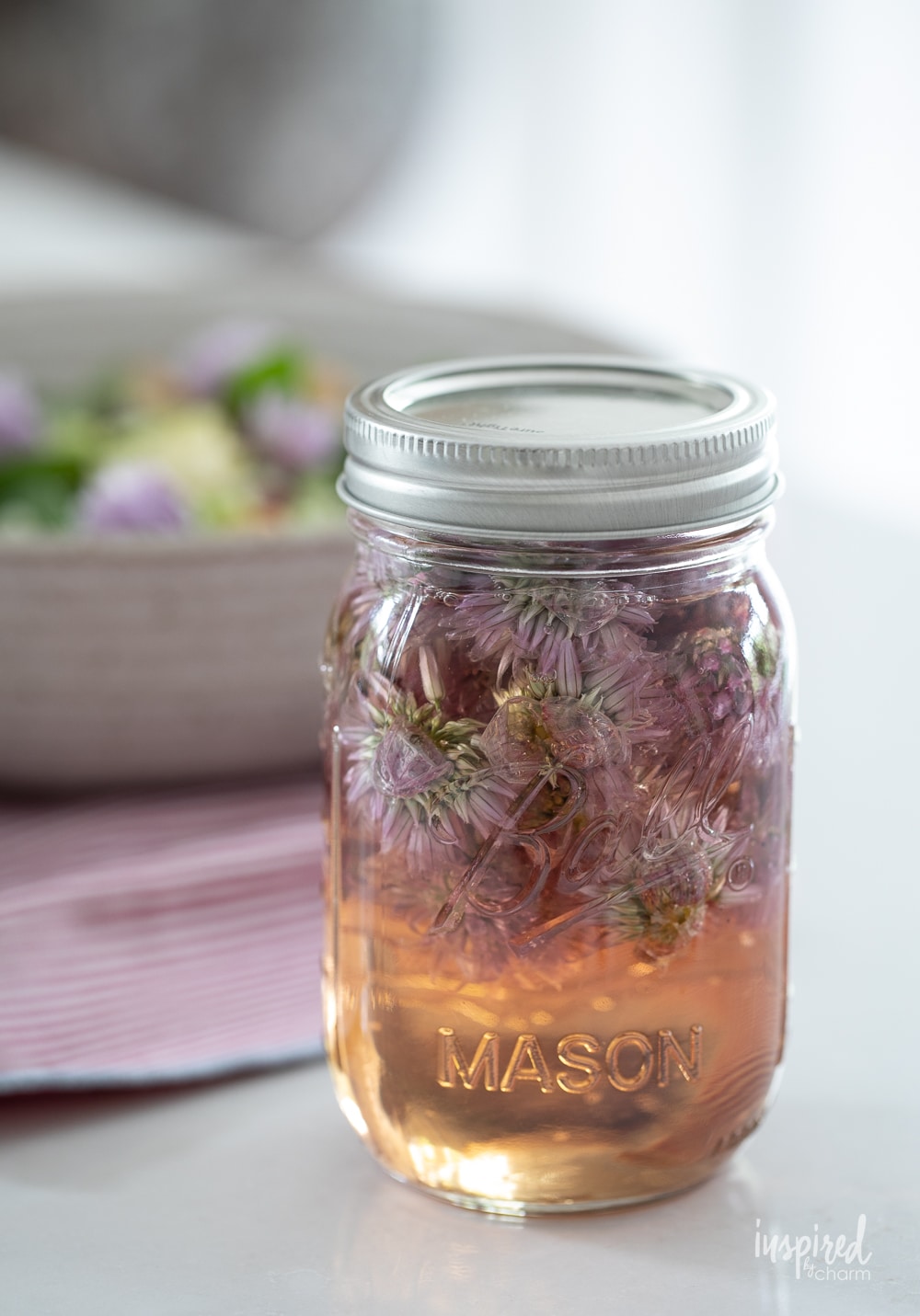
Frequently Asked Questions
Can I use the chive blossoms after infusing the vinegar?
The chive blossoms are not typically consumed after the infusion process. The blossoms may have lost some of their texture and may not be as palatable as before. It is best to discard the used chive blossoms after straining the vinegar.
Can I use the vinegar right after making it or should I wait?
While you can use the vinegar shortly after making it, it is best to allow it to infuse for the recommended two to three weeks. This will allow the flavors to fully develop and create a more robust and aromatic vinegar.
How should I store the chive blossom vinegar?
Store the chive blossom vinegar in a cool, dark place, such as a pantry or cupboard, and make sure to seal the bottle or jar tightly. This prevents light and air exposure which can affect the flavor and quality of the vinegar.
How long does the chive blossom vinegar last?
When stored properly, chive blossom vinegar can last for several months. However, it’s important to note that the flavor may start to diminish over time. If you notice any signs of spoilage, such as an off odor or discoloration, it’s best to discard it.
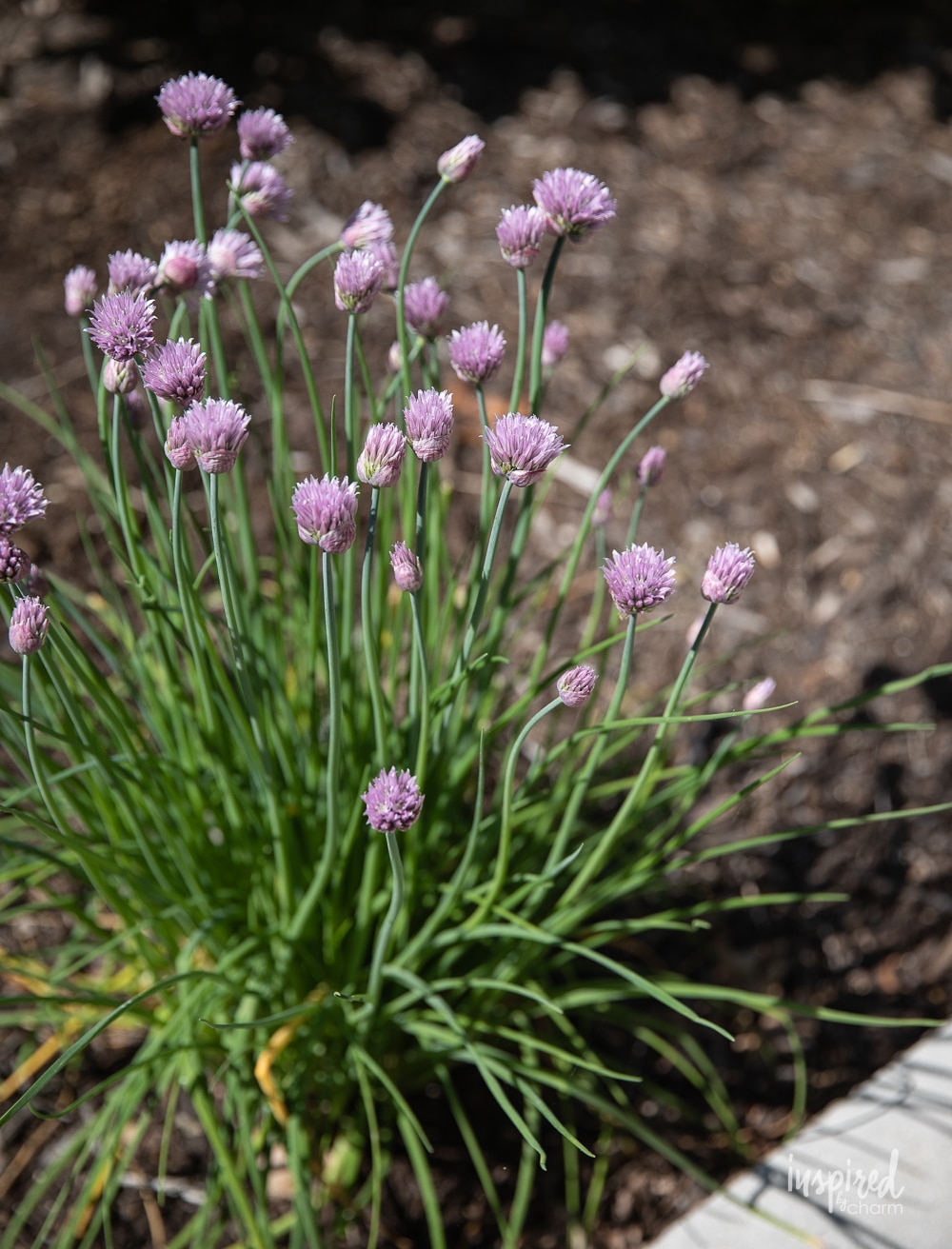
More Recipes You May Enjoy
- Homemade Poppy Seed Dressing
- The BEST Croutons
- Red Pepper Jelly
- Cranberry Orange Marmalade
- Homemade Herb Butter
- Simple Syrup Recipe
So gather your ingredients, roll up your sleeves, and let this chive blossom vinegar become your homemade secret weapon in the kitchen. Will you give it a try? If you do, please leave a comment and a 5-star rating below.
Want more from Inspired by Charm? Follow along on Instagram and TikTok for daily updates and behind-the-scenes looks at my processes. There’s even more inspiration on Facebook and Pinterest!

Chive Blossom Vinegar
Ingredients
- 1 cup fresh chive blossoms
- 1 ½ cup white balsamic vinegar or the vinegar of your choosing
Instructions
- Begin by gently rinsing the chive blossoms under cool water to remove any dirt or debris. Pat them dry with a clean kitchen towel or paper towel.
- Place the chive blossoms in a clean glass jar or bottle with a tight-fitting lid.
- Pour the white balsamic vinegar (or your chosen vinegar) over the chive blossoms in the jar. Ensure that the blossoms are fully submerged in the vinegar.
- Use a clean spoon or chopstick to press down on the chive blossoms, gently bruising them to release their flavor.
- Seal the jar tightly with the lid and place it in a cool, dark place such as a pantry or cupboard.
- Allow the chive blossoms to infuse in the vinegar for about two to three weeks. During this time, the vinegar will take on the delicate flavor and vibrant color of the chive blossoms.
- Shake the jar gently every few days to help distribute the flavors and encourage the infusion process.
- After the infusion period, strain the vinegar through a fine-mesh sieve or cheesecloth into a clean bottle or jar. Discard the used chive blossoms.
- Store the chive blossom vinegar in a cool, dark place. It will continue to develop flavor over time and can be used in various recipes, dressings, and marinades, or as a flavorful addition to salads.

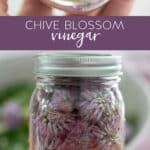
I made this and then totally forgot about it. Ha! I just strained out the flowers and the chive vinegar is so good! I sprinkled it on my French fries. YUM!
If you make this with Champagne Vinegar, it turns out to be a lovely lavender color! – it makes a sweet gift along with a bottle of olive oil!
I’ll definitely have to try that! Thank you!
xo Michael